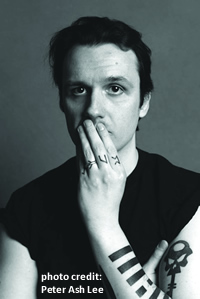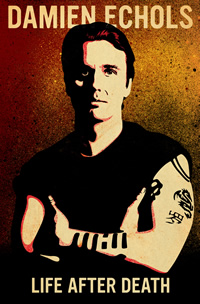Chronicling Life and Death
Damien Echols of the West Memphis Three has received wide-ranging notice for Life After Death, his memoir about surviving eighteen years on death row
Damien Echols’s memoir has drawn praise and attention from a broad range of media outlets. Life After Death chronicles Echols’s long years of incarceration on death row as a member of the West Memphis Three, teenagers convicted in 1993 of murdering three young boys in Arkansas. In the following years, a series of documentary films shined a light on the failures of authorities and lack of evidence in the case, and the attention led to new investigations and the probability of a new trial. In 2011, Echols, along with Jason Baldwin and Jessie Misskelley Jr., were released through a rare Alford Plea, which grants freedom to the convicted but does not declare them innocent.
 Another documentary, West of Memphis, which producer Peter Jackson has called “the most important film” he’s ever made, is set for theater release on December 25. Meanwhile, Echols is still fighting for full exoneration, both for himself and for the other men convicted with him. This struggle for understanding is evident in the excruciating detail with which Echols writes about his time on death row. His emphasis on the torturous aspects of his experience (in both prison life and the poverty-wracked Southern childhood preceding it) is the aspect of the book that critics have most often highlighted in their reviews.
Another documentary, West of Memphis, which producer Peter Jackson has called “the most important film” he’s ever made, is set for theater release on December 25. Meanwhile, Echols is still fighting for full exoneration, both for himself and for the other men convicted with him. This struggle for understanding is evident in the excruciating detail with which Echols writes about his time on death row. His emphasis on the torturous aspects of his experience (in both prison life and the poverty-wracked Southern childhood preceding it) is the aspect of the book that critics have most often highlighted in their reviews.
In a starred review, Publisher’s Weekly praises Life After Death as “searing,” “finely wrought,” and “heart-wrenching.” New York Times critic Janet Maslin calls Life After Death a “haunting book,” describing Echols’s new life outside prison as “mind-bending new circumstances for a guy who grew up as an impoverished loner, sardonically described himself as white trash, and spent his years of incarceration noticing the most grotesque, dehumanizing aspects of prison life. Yet ‘Life After Death’ tries to reconcile all these extremes into a single narrative, and to a great extent it accomplishes this magic trick.”
Similar praise for Life After Death has appeared in a wide variety of other publications. Clark Collis, writing for Entertainment Weekly, notes that Echols’s vivid prose means “the reader is as close to sharing his plight as any sane person would care to be.” “What makes ‘Life’ special is Echols’ honesty and superb writing,” notes Lee Coppola in The Buffalo News. “Echols is a solid storyteller, so when he’s describing his cell, or his fellow inmates—one looks like Iggy Pop and tapes crickets all over his body—Life After Death is compelling reading, a first-person glimpse into the pure hell of death row,” writes Josh Modell in the A.V. Club.
The New York Times continued its coverage of Echols with a piece about his joint appearance with Johnny Depp at a book signing in Union Square. Reporter Dave Iztkoff describes Echols’s difficulty in navigating the bustling city, not to mention his unease at being the center of such attention: “Praised for the self-assurance he had shown at the book event, Mr. Echols said it was all an illusion. ‘I was scared to death,’ he said. ‘The more scared I get, the calmer I am.’”
 Echols has given many such interviews while on tour to promote both Life After Death and the upcoming documentary film. In a Q&A with Pitch, he reveals details about his writing process, creating the book from many journals and letters he wrote in prison. When asked about the book’s non-chronological structure, Echols says, “[In] a way, my life is sort of like that. Most people live their lives almost like a succession of events. One day follows the next day, follows the next day. And you have definite things that mark time. I was 18 years old when I went to prison. I spent 18 years in, so literally half my life was spent in prison. So, I lived forward for the first 18 years of my life. The second 18 years, I lived either standing still or looking back, going backwards. I wasn’t making new memories, at least none that I wanted to keep.”
Echols has given many such interviews while on tour to promote both Life After Death and the upcoming documentary film. In a Q&A with Pitch, he reveals details about his writing process, creating the book from many journals and letters he wrote in prison. When asked about the book’s non-chronological structure, Echols says, “[In] a way, my life is sort of like that. Most people live their lives almost like a succession of events. One day follows the next day, follows the next day. And you have definite things that mark time. I was 18 years old when I went to prison. I spent 18 years in, so literally half my life was spent in prison. So, I lived forward for the first 18 years of my life. The second 18 years, I lived either standing still or looking back, going backwards. I wasn’t making new memories, at least none that I wanted to keep.”
In an interview with The Village Voice, Echols describes the way Stephen King’s novels influenced the development of his own style: “You know how when you listen to music and you hear a beat to the song? And you could sit down and maybe write a new song along the beat of the old one? It’s the same thing for me when I read. I read these novels until that beat became sort of ingrained in me. So, when I sat down to write, I wrote to that beat.”
“What I’m hoping with this book is that people will appreciate the writing style itself, and they’ll want to read about more than just the case,” Echols told Arizona Central. “That would allow me to go on and write about other things.”
In an interview with the Austin Chronicle, Echols reflected on the difference between his own account of the events in Life After Death and other versions: “It seems like there’s a lot of history being rewritten,” he said. “I wanted to preserve the real history of what was happening and who was doing what, just so history wasn’t completely rewritten by people who just wanted to make a dollar on a piece of pop culture.”
On the other hand, speaking with E! Online, Echols acknowledged the support he received from celebrity figures, who helped raise money for his defense and who offered crucial emotional support. “If it wasn’t for Peter Jackson, and if it wasn’t for Eddie Vedder, I really honestly have no idea what we would have done,” he said. “Johnny [Depp] has been with us every single step of the way since I got out. Obviously, this isn’t helping his career in any way. This is something he is doing entirely to help me.”
Grateful as he is to be free, Echols has also been candid about the difficulties he faced in reentering his life after eighteen years behind bars. He discussed these issues on WNYC’s The Leonard Lopate Show, The Huffington Post, and on stage at UCLA with musician Dave Navarro on the UCLA campus.
To read Chapter 16‘s review of Life After Death, click here.
For more updates on Tennessee authors, please visit Chapter 16‘s News & Notes page, here.

